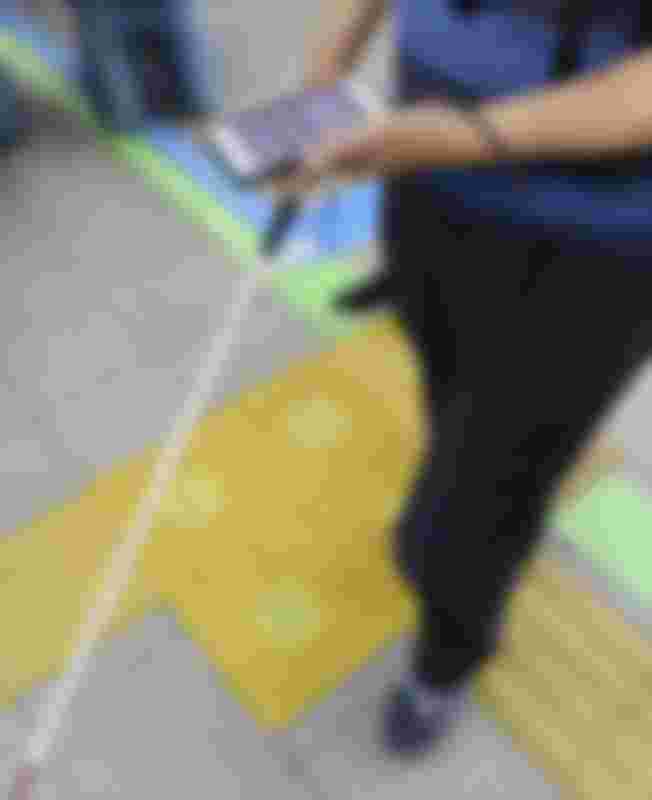A man is seen holding out a smartphone to read the QR codes set up on tactile blocks at JR Shin-Kobe Station, as part of a test of the new system to help guide people with visual impairments that was demonstrated to the press on Sept. 3, in Kobe, Hyogo Prefecture. (Mainichi/Tatsuya Onishi) OSAKA -- Amid a series of high-profile incidents in which visually impaired people have lost their lives or been injured while using train stations, the latest technology is increasingly being employed to improve their safety and convenience when using railway facilities.
Among these initiatives, West Japan Railway Co. (JR West) on Sept. 3 revealed its new navigation system, which uses a combination of smartphone technology and QR codes to convey information about train stations, to the press in the western Japan city of Kobe. People with visual impairments consider train platforms as similar to dangerous bridges with no handrails, but people including those involved with developing the safety system have high hopes for the scheme. On the morning of Sept. 3 at the Sanyo Shinkansen section of Shin-Kobe Station, a man using a white cane held out his smartphone as he steadily walked on the floor's tactile paving. QR codes were seen on the paving blocks situated at important points, including those that connect ticket barriers to platforms, and at sections where the path splits or reaches a flight of stairs.
When the man reached one of the QR codes, a voice would play from his phone, and guide him to the intended destination he inputted earlier. The man testing the technology for the first time, a 30-year-old resident of Osaka's Suminoe Ward who works for an association, smiled and said, "I'd never used Shin-Kobe Station before, but I could walk around at my normal speed. I felt happy and like I was doing something new." Progress Technologies, a firm based in Tokyo's Koto Ward, has been developing the navigation system used at the station since 2016. In the eastern Japan region of Kanto, they have already worked in cooperation with Tokyo Metro Co. to do on-site tests of the system at subway stations.
In the Kansai region in western Japan, the company intends to do tests to see if the system can provide accurate information for trains with different numbers of carriages and different destinations, among other considerations. The company's head, Yuichi Konishi, said, "In the future we'll use artificial intelligence (AI), and be able to detect the locations of tactile blocks and objects people might walk into."

The smartphone with the information read from QR codes, and the QR codes on the tactile blocks, are seen in this image taken at JR Shin-Kobe Station, in Kobe, Hyogo Prefecture, on Sept. 3, 2020. (Mainichi/Tatsuya Onishi)
Behind the development of technologies to help people with visual impairments is the now widespread use of smartphones in society and improvements in image recognition technology. In February 2020, Kyocera Corp. announced it was developing a "smart cane." The concept involves having signal-emitters installed at specific points, such as on the edges of platforms and the parts where train cars connect.
In the event that a smart-cane user approaches the emitters, they would cause vibrations in the cane, which is fitted with a receiver, and issue a spoken warning of the dangers from the person's phone. As the project just started in 2019, the company reported that it wishes to do on-site tests at train stations. From June, Kintetsu Railway Co. has outfitted an AI system at the west Japan city of Nara's Yamato-Saidaiji Station.
The entrance to the ticket barrier has a camera installed, and the AI automatically picks up when a person with a cane or a wheelchair user passes its lens. Once it has done so, it informs a member of staff responsible for helping people that they are there. The railway firm said that as some people who may need help struggle to approach others to ask for assistance, it hopes the new system will "p
